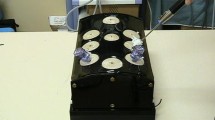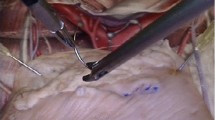Abstract
Background: The aim of the study was to examine the effect of the angle between optical axis of the endoscope and the instruments’ plane (OAIP) on the monitor display angle (approach angle between the two instruments on a two-dimensional monitor) and endoscopic task performance. Methods: Two experiments were carried out in the Advanced Dundee Endoscopic Psychomotor Tester (ADEPT) using a standard two-dimensional video endoscopic system. In the first experiment, the monitor display angle was measured during use, with OAIP angles ranging between 0 and 80° (at 10° increments) and manipulation angles varying between 45 and 120° (at 15° increments). In the second experiment, 10 surgeons tied 500 intracorporeal knots with OAIP angles of 0° (optical axis in the same plane as the instruments), +15° and +30° (viewing above the instruments’ plane), and −15 and −30° (optical axis looking from below instruments’ plane). The end points were the execution time and knot quality score (KQS). Results: In the first experiment, instruments entered the visual field from lateral sides of the monitor with an apparent 180° monitor display angle with a 0° OAIP angle, whereas the monitor display angle approached the actual manipulation angle between the two needle drivers when an 80° OAIP angle was used. In the second experiment, the instruments appeared to enter the image field from the side of the surgeon when the endoscope viewed the instruments from above, whereas instruments entered the field from the opposite side to the surgeon when the endoscope viewed instruments’ plane from below. As a result, use of 0 and +15° OATP angles yielded significantly shorter execution times: 70 s compared to 83, 93, and 77 s for +30, −30, and −15° OAIP angles (p < 0.001), with KQS of 39° and 40 vs 38, 36, and 34%, respectively (p = 0.257). Conclusions: The angle between the optical axis of the endoscope and instruments’ plane determines how the instruments appear to enter the operative field. The monitor display angle between the instruments is different from the real manipulation angle unless the OAIP angle is near 80°. The apparent entry of instruments into the operative field becomes intuitive for the surgeon only if the endoscope is viewing from above or in the same plane as the instruments. Hence, the best performance for endoscopic knot tying is obtained with this configuration, and execution time increases significantly with viewing from below the instruments’ plane.



Similar content being viewed by others
References
T Emam TG Frank GB Hanna G Stockham A Cuschieri (1999) ArticleTitleRocker handle for endoscopic needle drivers—technical and ergonomic evaluation of infrared motion analysis system. Surg Endosc 13 658–661 Occurrence Handle10.1007/s004649901068 Occurrence Handle1:STN:280:DyaK1Mzhs1eqsA%3D%3D Occurrence Handle10384070
GB Hanna A Cuschieri (1999) ArticleTitleInfluence of optical axis-to-target view angle on endoscopic task performance. Surg Endosc 13 371–375 Occurrence Handle10.1007/s004649900992 Occurrence Handle1:STN:280:DyaK1M7psVyrsg%3D%3D Occurrence Handle10094750
GB Hanna T Drew P Clinch B Hunter A Cuschieri (1998) ArticleTitleComputer controlled endoscopic performance assessment system. Surg Endosc 12 997–1000 Occurrence Handle10.1007/s004649900765 Occurrence Handle1:STN:280:DyaK1c3pvVehug%3D%3D Occurrence Handle9632879
GB Hanna TG Frank A Cuschieri (1997) ArticleTitleObjective assessment of endoscopic knot quality. Am J Surg 174 410–413 Occurrence Handle10.1016/S0002-9610(97)00129-3 Occurrence Handle1:STN:280:ByiH2sjhtVU%3D Occurrence Handle9337164
GB Hanna S Shimi A Cuschieri (1997) ArticleTitleOptimal port locations for intracorporeal endoscopic knotting. Surg Endosc 11 397–401 Occurrence Handle10.1007/s004649900374 Occurrence Handle1:STN:280:ByiB2M%2Fnt1Q%3D Occurrence Handle9094288
R McIntyre CP Driver S Miller (1996) ArticleTitleThe anterior abdominal wall in laparoscopic procedures and the limitations of laparoscopic simulators. Surg Endosc 10 411–413 Occurrence Handle10.1007/s004649910077 Occurrence Handle1:STN:280:BymB28rptlE%3D Occurrence Handle8661790
Acknowledgments
This work was supported by Grant (K/MRS/50/C2686) from the Chief Scientist Office of Scotland to A. Cuschieri and G. Hanna.
Author information
Authors and Affiliations
Corresponding author
Rights and permissions
About this article
Cite this article
Patil, P., Hanna, G. & Cuschieri, A. Effect of the angle between the optical axis of the endoscope and the instruments’ plane on monitor image and surgical performance . Surg Endosc 18, 111–114 (2004). https://doi.org/10.1007/s00464-002-8769-y
Received:
Accepted:
Published:
Issue Date:
DOI: https://doi.org/10.1007/s00464-002-8769-y




